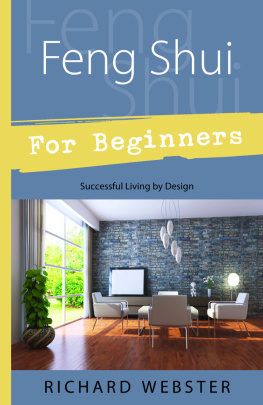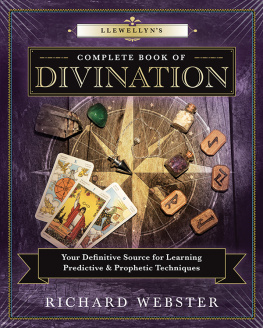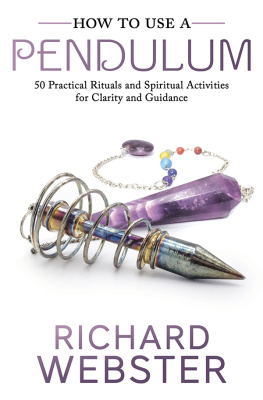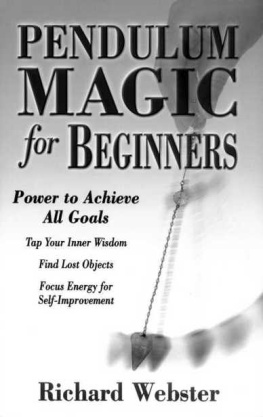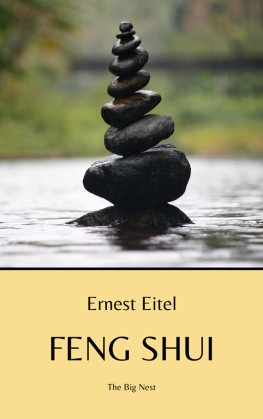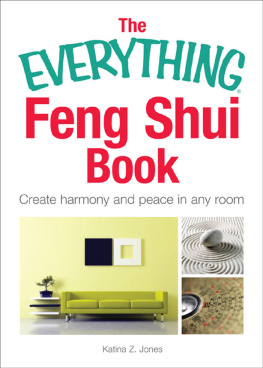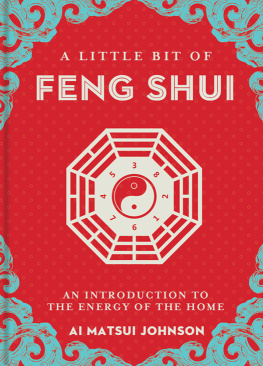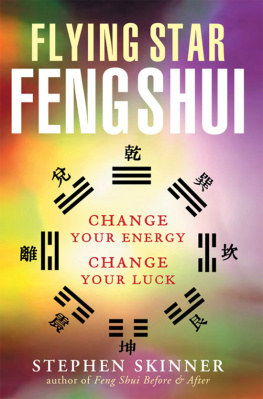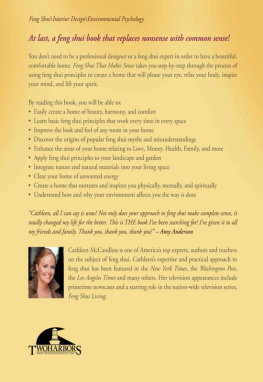About the Author
Richard Webster was born in New Zealand in 1946, where he still resides. He travels widely every year, lecturing and conducting workshops on psychic subjects around the world. He has written many books, mainly on psychic subjects, and also writes monthly magazine columns.
Richard is married with three children. His family is very supportive of his occupation, but his oldest son, after watching his fathers career, has decided to become an accountant.
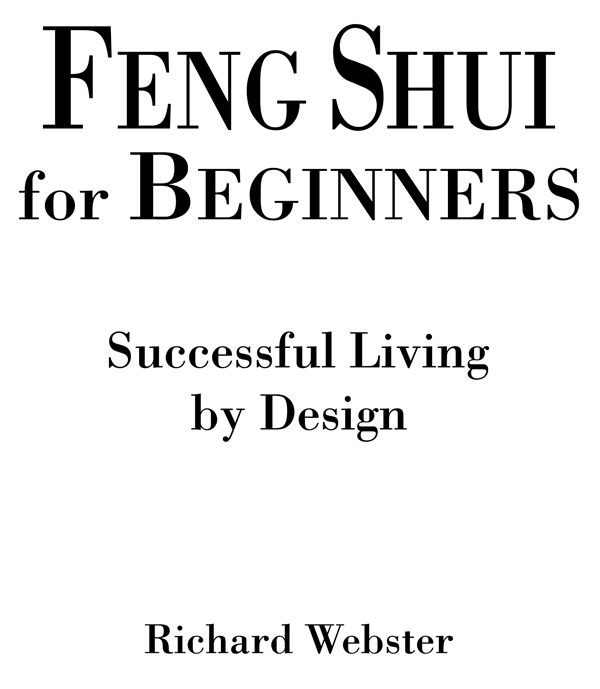
Llewellyn Publications
Woodbury, Minnesota
Copyright Information
Feng Shui for Beginners 1997 by Richard Webster
All rights reserved. No part of this book may be used or reproduced in any matter whatsoever, including Internet usage, without written permission from Llewellyn Publications, except in the form of brief quotations embodied in critical articles and reviews.
As the purchaser of this e-book, you are granted the non-exclusive, non-transferable right to access and read the text of this e-book on screen. The text may not be otherwise reproduced, transmitted, downloaded, or recorded on any other storage device in any form or by any means.
Any unauthorized usage of the text without express written permission of the publisher is a violation of the authors copyright and is illegal and punishable by law.
First e-book edition 2012
E-book ISBN: 9780738728476
Cover photo: iStockphoto.com/roseburn3Dstudio
Cover design: Ellen Lawson
Interior illustrations: Carla Shale
Interior photos: Richard Webster
Editing and book design: Amy Rost
Llewellyn Publications is an imprint of Llewellyn Worldwide Ltd.
Llewellyn Publications does not participate in, endorse, or have any authority or responsibility concerning private business arrangements between our authors and the public.
Any Internet references contained in this work are current at publication time, but the publisher cannot guarantee that a specific reference will continue or be maintained. Please refer to the publishers website for links to current author websites.
Llewellyn Publications
Llewellyn Worldwide Ltd.
2143 Wooddale Drive
Woodbury, MN 55125
www.llewellyn.com
Manufactured in the United States of America
For two special friends, David and Penny Alexander.
Acknowledgments
Many people have helped me with this book. I would like to especially thank my friend Dr. David Himelrick for sending me valuable information. I would also like to thank Tai Lau, Charles Hai, Carl Herron, Jon Kealoha, Albino Gola, and Mark Edward for their valuable advice and support.
Contents
Chapter 1:
What Is Feng Shui?
Chi Yin-Yang The Eight Trigrams
The Pa-Kua The Five Elements
Chapter 2:
The Form School
Shan Shars Choosing Land
Choosing a House Inside the House
Chapter 3:
The Compass School
The Individual Trigrams Using the Pa-Kua
The Lo Shu Magic Square
The Aspirations of the Pa-Kua
Chapter 4:
The Flying Star
Chapter 5:
The Luo-Pan
Using the Luo-Pan
Chapter 6:
Shar Remedies
Chapter 7:
Feng Shui for Success
Chapter 8:
Feng Shui in the Home
The Front Door The Staircase
The Living Room The Bedroom
The Kitchen The Dining Room
The Study The Toilet The Bathroom
Chapter 9:
Designing Your Own Home
Chapter 10:
Feng Shui in the Garden
Flowers Fruit Trees Other Considerations
Chapter 11:
Feng Shui in
the Work Place
Chapter 12:
Conclusion
Elements and Signs for the Years 1900 to 2020
Element at Time of Birth
Personal Pa-Kua for Year of Birth
Central Position Numbers for Months of the Year
Central Position Numbers for Years 1901 to 2017
List of Illustrations
Introduction
Hong Kongs Peninsular Hotel is shaped like a magnet
to attract positive energy from the harbour it faces.
Feng shui experts were brought in at all stages of
planning for the Hong Kong and Shanghai Bank.
Feng shui experts determined the best position for
Stitt, one of two stone lions outside the Hongkong
and Shanghai Bank. Stitt and his counterpart, Stephen,
had to be repositioned simultaneously so neither would
become jealous.
The entrance to the Hang Seng Banks head office
resembles a huge mouth that is unable to close.
Some feng shui experts say the shape of the Bank
of China is unlucky, and its sharp, angled sides
create poison arrows of negative energy.
Chapter 1
: The pa-kua.
: The Ssu Hsuang.
: The eight trigrams of the pa-kua.
: The cycle of production for the five elements
(also known as the cycle of birth).
: The cycle of destruction for the five elements.
: The cycle of reduction for the five elements.
Chapter 2
: Fortunate feng shui sites have animal
symbolism in all four directions.
: River inlets or tributaries bring beneficial chi to a home.
: Common shars.
: Common shars.
: Common shars.
: Common shars.
: Common shars.
: Common shars.
: Common shars.
: Common shars.
: A low wall will symbolically finish off a U-shaped house.
Chapter 3
: The Latter Heaven Sequence
: Determining Your Personal Pa-Kua Trigram.
: A homes trigram is determined by its sitting and facing directions.
: Eight areas of a home, as determined by the Latter Heaven Sequence.
: A Tui home.
: Positive and negative directions can also be determined by laying the pa-kua (Latter Heaven Sequence) over the floor plan.
: A square home has better feng shui than a long, thin, rectangular home.
: If your home is an unusual shape, divide it into smaller sections, then evaluate each.
: The magic square for a Tui home.
: Superimpose the magic square over the floor plan to evaluate the home.
: The aspirations of the pa-kua.
: To find the aspirations, place the pa-kua with Kan parallel to the front door.
Chapter 4
: The markings on a tortoise shell were a pattern for a perfect three-by-three magic square.
: The Lo Shu.
: The Period of Seven (19842003).
: Pattern of movement.
: July 1999.
: March 1997.
: The charts for the year 1999 and the month of July are placed over the chart for the Seven Period.
: The charts for the year 1995 and the month of September are placed over the chart for the Seven Period.
: Example floor plans.
: Example floor plans.
: Example floor plans.
Chapter 11
: A small office building between
two larger buildings is not a good location.
Introduction
In 1971 I decided to write a book. It took some three months to write. The first publisher I sent it to accepted it, and the book was duly published. For someone who had always wanted to be a writer, this was a great thrill. I was under way! I had ideas for several other books, but somehow years passed and the books remained as dreams in my head. My second book did not appear for five years. At the time I had every excuse in the world for not writing it. I was busy at work. I had a young family. I had little free time. I didnt realize at the time that feng shui was also involved.
We moved house immediately after I had written my first book, and my desk was placed in an attractive position beside a window overlooking our garden. I would sit at my desk and think about writing, but I never seriously got around to writing anything. Then, in 1977, I changed the layout of my office, and placed my desk against another wall at a ninety-degree angle to where it had been before. I immediately started writing seriously again. At the time I thought it was coincidence, but once I became interested in feng shui and checked the room I discovered that I had unconsciously moved my desk from a negative position to a highly favorable one. This was my first personal experience of feng shui, and it was an accidental one. However, I was already aware of how feng shui had helped friends become happier and more successful.
Next page
